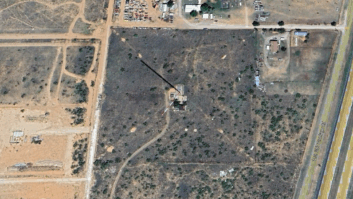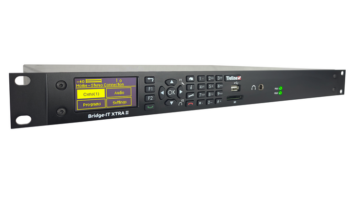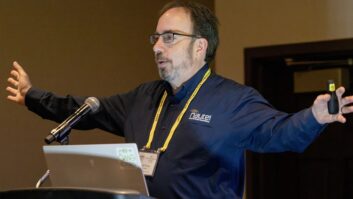Photos
(click thumbnail)Fig. 1: This old Hubble connector adapter sparked lots of memories.
(click thumbnail)Fig. 2: An inexpensive pair of fuse pullers removes blown fuses safely. When winter weather blasts most of the country, site neighbors can be a blessing, especially if you maintain multiple sites. For instance, if you suspect a problem with power, you can check in with the neighbors to see if they have juice.
I made it a practice to supply several neighbors with T-shirts or extra concert tickets. They never let me down, and on more than one occasion they served as my remote “eyes,” tracking down would-be vandals or others wandering around my seven-acre site.
Veteran engineer Tom Osenkowsky, an RW contributor, notes a flip side of being neighborly.
Once, he was building a transmitter facility in Aruba and the phone rang. Tom assumed it was the owner calling, but no; it was a man asking in Spanish if Tom had seen his goats. Tom replied he hadn’t and went on with his work.
When the owner arrived, Tom related the call. The owner said the caller was the neighbor across the street, whom station staff would call whenever the transmitter went off to determine if the failure was a power outage. And it turned out that one of Tom’s jobs on the island was to shoo goats away after the staff had laid in a new ground system. Goat hoofs and newly laid radials don’t mix.
* * *
From the Gil Housewright transmitter service journal comes a real mind-bender.
New site, new transmitter. The electrician installs a fused disconnect, ties the wiring into the transmitter and leaves. The engineer throws the disconnect and tries to turn the transmitter “on” and nothing happens.
The station staff brings out the digital volt meter. Voltage is measured at the disconnect, voltage is measured past the fuses, voltage is even measured where the AC wiring ties into the transmitter. The transmitter still won’t turn on — there aren’t even any lights on the transmitter. Time to call Gil.
Can you figure out what was wrong? Read on for the answer.
* * *
I still get comments from engineers who saw the Hubbell connector modified to work with a more modern phono (RCA) plug, found at WPIC(AM) by Wes Boyd and Dan Kerr. We discussed it our column of Sept. 16, 2005, which is available in our online archives.
That cable stirred a lot of memories! John Fischer works at KFUO(AM) in Clayton, Mo., as chief engineer. This station went on the air in 1924 and has a lot of radio history.
For many years, the station used these Hubbell connectors for microphone cables. At KFUO, they were still using them up to 1970 or so. They are now missing from the mike remote cables, but the studios still have the Hubbell plugs mounted in the wall for plugging in studio microphones from long ago.
John recalls a similar adapter cable used to feed a microphone into a Wollensak tape recorder. Now that’s history!
* * *
Marlin Taylor’s first paying job in radio was in the summer of 1955. He was hired by WTNJ in Trenton, N.J., to be engineer for a weekly remote from a car dealership — provided he bring along the necessary equipment, which the station did not have.
That gear included a PA system. The station microphones were all from the 1930s except the one in the control room. Marlin decided to provide his two RCA 47s, for which he had bartered and on which he had replaced the ribbons.
The only problem: the station’s four-channel Western Electric remote board used the Hubble “twist-locks.” Marlin purchased several and proceeded to create two adapters with XLR females for his mikes.
Because the station’s portable turntable was large, bulky and marginal in performance, he created another adapter with an RCA female jack and started bringing along his RCA 45 RPM changer.
The setup performed well and delivered a great sound for circa 1955 AM radio. The Western Electric had no cue channel, so Marlin simply wore headphones and cued softly on the broadcast channel as the two DJs chattered.
Fifty years later Marlin is with XM Radio, which he joined at the end of 2000. It’s his privilege to bring joy to people’s lives through his programming on the 1940s and Beautiful Music channels. Yes, Marlin is a programmer, not an engineer — though he adds that he knows just enough technical stuff to give an engineer a headache. He recently celebrated his 70th birthday and said he is proud to be XM’s oldest employee, at least as measured in years.
* * *
And consultant Lew Collins of Broadcast Signal Lab in Boston writes that early on, the film industry adopted the Hubbell twist-lock AC power plugs and receptacles for its “standard” microphone connector system. Decades later the Cannon “P,” Cannon “UA,” and the Cannon XL (now XLR) would be adopted on a case-by-case basis.
It was not unusual to see film and sound reinforcement systems with Hubbell ML-1 and similar connectors used for their low-impedance mikes. Some radio stations followed the established film practice of using these same power connectors.
It’s interesting to note that the early Cannnon “P” connector, so favored by RCA Broadcast, actually was an AC power connector (hence the “P” designation) and was rated at 15 amps. Sync-sound “interlock” systems used these “P” connectors for their original purpose, providing three-phase power and/or Selsyn interlock signals to the camera(s) and recorder(s).
* * *
Tom Williams of Audio Precision drops us a line that AP Calibration Services are now open for business at the Beaverton factory. The company now offers accredited calibrations on most current instruments (AP2700, System Two, APx, ATS-2) and will add more this year.
All supported new instruments sold by Audio Precision will come with a calibration report and certificate demonstrating the unit meets or exceeds its published specification. What’s the advantage? If the unit does not meet specifications, AP can repair or adjust it immediately, no extra shipping, which translates into faster service.
Why choose AP over third-party calibration services? AP says the factory test technicians are dedicated audio engineers who know audio and the AP equipment. Couple this with their automated test systems and the result is accurate but fast turnaround.
For pricing or more information, call AP service at (800) 231-7350 or e-mail service (at) ap.com.
* * *
Note: The print edition Workbench in the Feb. 14 issue contained an incorrect Web address for Modulation Sciences. The address is www.modsci.com.
* * *
OK, so there’s voltage to the transmitter, but no lights and no operation.
Let this be a reason to go out and buy a voltmeter with a meter and not a digital display. There’s a reason those old Simpson 260s were such trusted test instruments.
After a lot of head scratching, the station contacted Gil. He asked that the fuses be removed and checked. Though both fuses were newly installed by the electrician, one was bad. The DVM was reading backflow or “phantom” voltage, which would not be read on a metered instrument.
So if you only have a DVM to measure AC voltages, what do you do? Set the DVM for an AC voltage reading higher than you’ll be measuring, then place the probes across the fuse, so the meter is in parallel with the fuse.
If the fuse is bad, you’ll see a voltage displayed (as the meter shows a voltage “drop” across the fuse). If the fuse is good, zero volts will be displayed, because there would be no voltage drop across the fuse.
This is a neat way to check fuses, especially those used in transmitters and in three-phase applications. You won’t have to power down and remove the fuse (to check with the ohmmeter function).
By the way, if you don’t have a fuse puller, as shown in Fig. 2, pick one up. They’re not expensive and they beat using a screwdriver to pry out the fuses for replacement — safer too.









